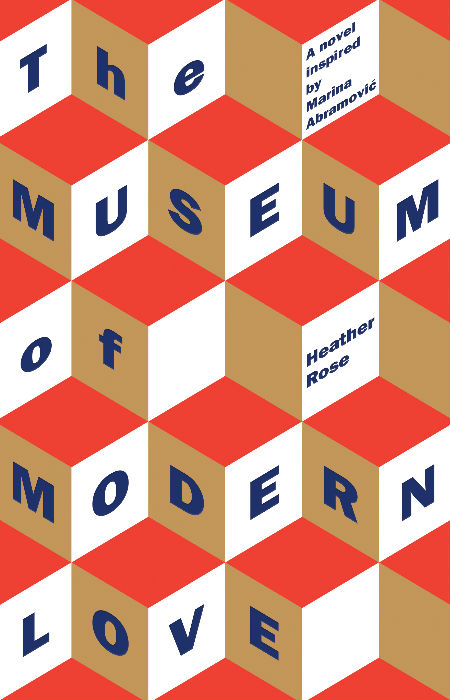
Human beings are an innately communal species.
It’s one of the things that define us – our need to not simply be in close proximity to our fellow women and men but to know them, laugh with them, drink and eat with them, and above all, profoundly connect with them in ways that transcend the superficial and gets down into the often messy but rewarding marrow of life.
In her exquisitely-well written Stella Prize-winning book, The Museum of Modern Love, Heather Rose explores a myriad of permutations on this theme, exploring what it is to like to be connected to other people and how it can go so easily wrong and yet, much of the time, so easily right.
It’s the way she launches into her insightfully meaningful and often quirky exploration of connectedness that really defines this beautiful novel, with the entire narrative framed around real-life artist Marina Abramović, who has made a much-storied career out of examining the many and varied ways we relate to each other in her performance-driven art.
“Love accounted for so many things … He [Arky] had exhibited all the signs of love. He had felt himself love Lydia over and over again. And there has been the bad patches. When she was sick. Unrecognisable. Not the Lydia he knew. The coronor has been right. Familiarity was dangerous.” (P. 47)
Via such bold artistic and humanistic experiments as her 1974 Rhythm Zero installation where she placed 72 items on a table, some benign such as grapes and a feather, others distinctly less so such as a gun, a bullet and a knife, which she invited those who saw over six hours to use in any way they saw fit while she remained passive throughout, Abramović has constantly asked people to consider what connection means to them.
For some people it’s confronting, others strangely comforting, with a range of responses in-between, all of which found expression at the Museum of Modern Art (MoMA) in New York City between March and May 2010 when she spent 75 days sitting at a table for seven hours with no food, drink or toilet breaks, inviting people to sit across from her and stare into her eyes.
As Rose notes in passing via one of her beguiling characters, all of whom you come to passionately care for in ways that reaffirm once again how much we connect to others, real or imagined, we aren’t not intrinsically predisposed as a species to that kind of intimate connectivity.
Perhaps it’s the idea of eyes being the window to the soul, or simply being that close and unadorned, with no speaking or other form of expression permitted, that leaves us feeling so exposed but as the 75 days go on, increasing numbers of people come to MoMA to either sit opposite her or to watch as others so, many of them walking deeply and irrevocably affected.

People like Arky Levin, a gifted film composer who is successful but not Hans Zimmer or Howard Shore-successful, who arrives one day at MoMA, reeling from the most significant life change of all for him thus far – the committing of his wife Lydia to a nursing home after a lifelong genetic blood condition places her first in a coma and then in a seeming vegetative state.
The kicker is what is already an emotionally untenable situation? Lydia has for reasons only he and his friends can guess that has issued a court order forbidding him from visiting her.
It falls to their daughter Alice, with whom Arky has a distant and occasionally adversarial relationship – for the most part they are simply an awkward father and daughter longing to connect but unsure how to do so – to tend to their mother and while their friends such as Healayas, arts editor for NPR and former partner of his close director friend Tom, and Hal, Arky’s agent, urge him to challenge the order, Arky is unsure what he should do in what is by any estimation an unusual situation for any spouse.
As Arky spends time watching Abramović, who is given voice via flashbacks to her past, and her present and the thoughts of those closest to her, small revelations of the most benign but impacting kind help him to not only come to terms with his new life as the sole occupant of an apartment made for two and a lifestyle sculpted for a couple and now lived out by only one, but to understand how he can move forward when everything he knew, the most important connection of his entire life, bears no resemblance to what came before.
“She was watching Marina Abramović in her white dress on this final day of enduring love. For hadn’t it been that for Abramović? An act of love that said, This is all I have been, this is what I have become in travelling the places of my soul and my nation, my family and my ancestral blood. This is what I have learned. It’s all about connection. If we do it with the merest amount of intention and candour and fearlessness, this is the biggest love we can feel.” (P. 266)
Along with other people he comes to meet at MoMA such as Jane Miller, a warm, thoughtful, considered middle school teacher from Georgia who’s on a much-needed break following the death of her beloved husband Karl, and those he does not such as Dutch-Chinese PhD student Brittika, who returns again and again from the Netherlands, all of whom are reeling from a loss of connection or feeling their way through to connections either new or existing and undeveloped.
The Museum of Modern Love pleasingly eschews glib, easy insights and obvious observations, choosing instead to meditate in beautiful nuanced and grounded of ways, with blissfully-lovely poetry of language to match, on the way in which we connect, or fail to properly connect with those around us.
There are some almost magically real aspects to the narrative such as ghost-like 500-year-old narrator who has acted as a muse for many gifted artists down through the centuries and the ghost of Abramović’s own mother Danica, who is used to explored the sometimes tortured relationship between mothers and daughters, but these add rather than detract from the overall thread of connection as the great linking human dynamic.
What makes The Museum of Modern Love work so well is that for all its rich ideas and genuinely meaningful philosophical musings, and they are many and rewarding, it is as real and true a musing on the human condition as you’re likely to get.
John Donne may have remarked on the indisputable fact that “no man is an island” but it is Rose who fleshes this out in a 21st-century setting, where connection is more elusive than ever despite social media and the like, giving us a gloriously beautiful, affecting treatise on the need for connection and how its loss and its regaining can be as wondrous as it is painful and banal, as magically real and transcendant as it simply choosing to be present with someone and seeing where it may lead, no matter the circumstances.